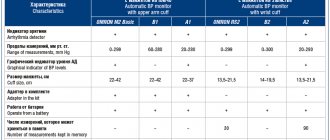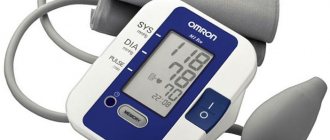Hello everyone! I continue to summarize and post in a condensed form my experience in electronics repair. I present my Top 10 most common malfunctions of tonometers, which was born as a result of accidental repairs of medical equipment and communication with other Masters. I won’t say that I’m a great specialist in this area, but I came across some things and successfully fixed them. Let's start the rating. The locations of malfunctions of tonometers and blood pressure meters are sorted by the frequency of occurrence of the malfunction.
Appearance
The body of the device is made in a modern design from high-quality material. The tonometer consists of an electronic unit and a cuff. The LCD display has 3 lines with large numbers that show lower pressure, upper pressure and pulse. In addition, the device is equipped with arrhythmia and blood pressure indicators. Using a blood pressure indicator, you can determine the risk of arterial hypertension, which is certainly very convenient for hypertensive patients.
AND UA-777 tonometer combines the best functions of automatic tonometers
The tonometer has a built-in memory cell for the last 90 measurements (with calculation of average values). The cuff is placed on the forearm and is adjusted depending on the girth of the arm (22-32 cm). Thanks to the intelligent Intellitronics program, the cuff is inflated smoothly and automatically. The device measures blood pressure and pulse.
The device is controlled by just one button, which allows it to be used by people without special skills. Operation is possible both from alkaline batteries and from an AC adapter.
The danger of hypertension
One of the main distinguishing features of arterial hypertension is that it very often has no symptoms. A person simply does not feel the increased pressure or quickly adapts to it, as a result of which the disease progresses for a long time, which leads to the appearance of organic changes in the vascular wall and heart muscle.
This is interesting! Changes in nervous regulation and the activity of biologically active substances stimulate the processes of atherogenesis and myocardial remodeling, aggravating the course of heart failure and atherosclerosis.
The clinical picture may appear in the later stages, when hypertension is accompanied by atherosclerosis of the coronary vessels, coronary heart disease and heart failure. Also, in patients suffering from hypertension, the risk of developing heart attacks, strokes and life-threatening arrhythmias increases sharply. Therefore, people at risk are recommended to be examined and measure their blood pressure levels as often as possible.
The automatic tonometer AND UA 777 from Medical is a high-quality device that allows you not only to measure blood pressure levels, but also to determine pulse indicators and the correct heart rhythm. Thanks to this, a person can easily and simply assess the state of his cardiovascular system. Due to its convenient use and high reliability, the device has become very popular among patients who do not have the opportunity to regularly visit a doctor or use mechanical tonometers.
Blood pressure should be measured regularly not only for those people who have already developed hypertension, but also for patients at risk. This will allow you to very quickly identify the initial stages of pathology.
It is important! Treatment of hypertension in the early stages is much easier. Very often, normalization of blood pressure can be achieved simply by following the rules of a healthy lifestyle. Even if there is a need to take medications, smaller doses and milder drugs are used.
Operating rules
To make correct measurements on the AND UA-777 tonometer, you need to follow the instructions:
- The device cannot be used at temperatures below 10° C or above 40° C, and the relative humidity should not exceed 85%.
- Before using the device, you must install batteries or connect the adapter to the electrical network. The display has special sensors that allow you to monitor the charge level of the tonometer.
- After the device is ready for use, it is necessary to place the cuff on the forearm so that it is at the level of the heart and 2 cm above the elbow.
- The tube through which the air is pumped should run along the hand parallel to the middle finger.
- The device is started/switched off using the “Start” key.
After the data is displayed on the screen, the cuff can be removed, and if necessary, save the results using the “Memory” button.
Rules for measuring pressure
To avoid the influence of extraneous factors and determine blood pressure levels as accurately as possible, you should remember several rules. There is no need to carry out the procedure immediately after physical or emotional stress. Before starting, it is advisable to catch your breath a little and calm down. After this, the cuff is put on the shoulder so that it fits tightly to the skin, but does not put pressure on the arm.
After pressing the button, you only have to wait a few seconds. At the same time, you need to relax your hand and turn your palm up. After this, the screen will display the systolic and diastolic pressure numbers, as well as the number of heartbeats per minute. If an arrhythmia is detected, this will be indicated separately. Unless special instructions have been made, the device itself determines how much air to pump in and how quickly to release it, which speeds up the process.
This is interesting! In healthy people, the pressure on different hands differs slightly. However, if the difference becomes more than 20 mm Hg. Art., this may be a sign of pathology.
Using the norms stored in the computer, the device also evaluates the pressure level and helps the patient navigate using a special color scale. The result is saved automatically. The memory contains up to 90 measurements, they can be easily viewed by opening the archive.
Features of interpretation of results
The monitor of the device displays lower pressure, upper pressure and pulse. If the user has an abnormal heart rhythm, a special “heart” icon will appear. The WHO scale shows the degree of risk of the disease. If it reaches the red mark, you should consult a doctor as soon as possible. This may signal serious disturbances in the functioning of the heart and blood vessels.
Classification of blood pressure levels according to WHO
To make sure that the data is correct, it is better to measure the pressure again after 10-15 minutes on the other hand. To obtain the most accurate data, you should remember that there are factors due to which indicators can be either overestimated or underestimated. These include:
- Excessive physical activity;
- Nervous tension;
- Full stomach;
- Increased body temperature;
- Sudden movements during the measurement procedure.
To avoid inaccuracies, pressure should be measured no earlier than 30-40 minutes after playing sports, eating food, drinking alcohol, or smoking tobacco. The measurement is taken in a calm state, in a comfortable position, sitting on a chair, breathing should be even and calm. Only in this case can you get the most accurate results.
Causes of hypertension
Modern science does not identify a separate reason that would lead to the development of arterial hypertension. It is believed that this is a multifactorial disease, the progression of which is caused by a combination of many external and internal environmental factors.
Reasons that increase the risk of hypertension include:
Together with a hereditary predisposition, this creates conditions for disruption of the regulation of vascular tone, which leads to the appearance of high blood pressure. At the same time, a universal method for early diagnosis of hypertension is regular determination of blood pressure.
Advantages of the UA-777 tonometer
The device has several advantages that can help when choosing a particular measuring device:
- Affordable price.
- Availability of memory for 90 measurements.
- Arrhythmia indicator.
- Easy to use, which is important for older people.
- Extended warranty period.
- Fully Russified description in the instruction manual.
Also a big plus is that there is a scale by which you can determine the degree of risk of arterial hypertension.
Tonometer readings indicating the risk of arterial hypertension
How can I check the device?
Nowadays electronic devices are the most popular because they have an affordable price. They do not require special skills from the user to measure blood pressure. Even older people, women and teenagers can cope with it. They are easy to turn on and off once the test is complete.
But measurement accuracy plays a major role. Electronic and automatic devices often malfunction. For this reason, constant checking of the tonometer is necessary to avoid mistakes.
If your friends or neighbors have another device whose accuracy has been verified, you can use it to control accuracy and settings. The second such device will help you check the accuracy of your tonometer readings and identify errors in measurements.
Some are of the opinion that it is better to carry out measurements with mechanical instruments. But modern automatic devices perform their tasks perfectly. Some of the high-quality tonometers are devices from Omron.
The parallel connection method helps to evaluate each of the two devices and check the tonometers for accuracy.
For proper verification, follow the following algorithm:
- devices are connected in parallel for simultaneous measurements;
- double testing is carried out for objective assessment, control tests;
- If necessary, check individual parts of the device.
A tonometer is a device for measuring blood pressure. In order for the device’s numbers to be accurate, it is necessary to check the electronic tonometer, configure it, and also know the intricacies of its operation. Such a device should find its place not only in people suffering from hypertension, but in general should be in every family.
IT IS IMPORTANT TO KNOW! Tabakov O.: “I can recommend only one remedy for quickly normalizing blood pressure” read more.
How to choose a tonometer?
For people with heart rhythm disturbances, it is best to purchase a tonometer with an arrhythmia indicator. Devices with a larger display will be convenient for the visually impaired. For older people, automatic type devices with a shoulder cuff are more suitable. Wrist blood pressure monitors are best purchased for people under 40 years of age.
For pregnant women, there are special devices that can determine the general condition of the woman. For children there are also blood pressure monitors with a special cuff.
For many, mechanical devices are more convenient than automatic ones, but for people with hearing impairments it is better to purchase the second option, since listening to tones in a mechanical version requires good hearing.
Device setup
You can check the tonometer for accuracy at a pharmacy. This check is carried out using a reference device. If any faults are detected at the time of purchase, you can return the device and replace it with a working one. There is also a special monitoring installation that is used to check the accuracy of the device. But it is expensive, so not everyone can afford to buy it for home setup of the device. You can also contact a workshop where it is possible to check the tonometer for accuracy and carry out repairs if necessary.
Reviews:
I have been suffering from hypertension for 3 years now. The doctor immediately said that I needed to measure my blood pressure every day, otherwise it would be difficult to choose the right dosage of medications. At first I used an old mechanical one, but measuring it myself was completely inconvenient. That's why I bought this machine gun, which I don't regret. It's fast, easy and even records an archive, which is very convenient.
I heard that previously automatic devices gave inaccurate results, but now this is no longer true. When I was in the hospital, I specially took my tonometer to check it too. The result coincided with what the mechanics showed, so I’m happy with the purchase. The main thing is that the device is small, you can easily take it to work and fit into your bag without any problems.
I don’t understand these devices, but my son said that it’s impossible without a tonometer. I read reviews for a long time and chose. In the end I took this one. As for me, it’s a little expensive, but it’s very comfortable and well made - nothing clicks, the cuff doesn’t stretch and fits well to the hand.
I took this tonometer because I needed a reliable and simple device. And it comes with a 7-year warranty, and it’s quite easy to use; you just need to press a couple of buttons to easily measure pressure. I think parents will like this, since they usually do not like equipment with complex controls.
I bought it on the recommendation of a friend; I think it’s a must to have something like this at home. What if someone has a crisis, and it wouldn’t be superfluous to just measure your blood pressure; I think that you need to take care of your health. I'm happy with everything about the device, I liked the cuff - it hardly puts pressure on my arm.
Electronic tonometer A&D UA 777 Tonometer A&D UA-888: Review and testing Electronic tonometer A&D UA 604
“Why do the batteries in my blood pressure monitor run out quickly? What batteries should be used in devices? When and how often do batteries need to be replaced? In electronic tonometers, it is necessary to use only alkaline (ALKALINE) energy-intensive batteries of the LR type. Only when using alkaline LR type batteries, the manufacturer guarantees uninterrupted operation of the device for 200-400 measurement cycles, i.e., with 2-3 measurements per day, the batteries will last for 4-6 months. It is not recommended to use type R batteries, since the capacity of these cells is not designed for long-term use in tonometers, and therefore it seems that the device is faulty due to the rapid discharge of the batteries. LR type batteries can be from any manufacturer; It is not at all necessary to use batteries only from “promoted” companies. It is necessary to change batteries when the corresponding symbol appears on the tonometer display, indicating their insufficient power. This symbol should not be taken into account as a sign of low battery power when it appears on the screen when the device is turned on simultaneously with other symbols. At this moment, the tonometer display is tested, and the presence of this symbol only indicates the operability of the display. “Do I need a network adapter, what types of network adapters can I use? Do I need to remove the batteries if using an adapter? Automatic shoulder blood pressure monitors have a socket for connecting an AC adapter. The adapter can be useful if the tonometer is used at home. If you take the blood pressure monitor with you, for example, to work, on a visit, or to the country, then for mobility it is more convenient to use batteries. When using an adapter, it is not necessary to remove the batteries from the device, since they are automatically turned off when the adapter plug is connected to the tonometer. Wrist tonometers do not have an adapter socket. You should not use adapters that are not recommended by the manufacturer, since adapters are subject to certain requirements for parameters (in particular, electrical safety), which a significant part of the adapters sold on the market do not satisfy. If you use an adapter that is not recommended by the tonometer manufacturer, the warranty on the device becomes void! Can similar sized batteries be used instead of batteries? You can use batteries, but it is ineffective. The thing is that the nameplate voltage of the batteries is 1.2 V. For the tonometer, 4 of them are needed, i.e. the total voltage will be 4.8 V, and 6.0 V is required. Therefore, the batteries, being fully charged, will not give voltage sufficient for long-term operation of the device, and before the next recharge they will work for no more than two weeks. After this, batteries that are not yet completely discharged will have to be recharged again, which will negatively affect their shelf life (if we are talking about nickel-cadmium batteries). Let's do the math: four sets of alkaline cells will last you about one and a half to two years; batteries can last the same amount of time, but they will have to be charged every two weeks. Therefore, in terms of cost and practicality, the use of alkaline batteries is preferable. Why do the results of blood pressure measurements with a mechanical tonometer differ from the values obtained by an oscillometric device? Why are the values obtained different each time with successive measurements of blood pressure using the oscillometric method, but with successive measurements with a mechanical tonometer the same? What is the true blood pressure value? Today, the “gold standard” for measuring blood pressure is considered to be the “N. S. Korotkov tone” method, recognized by the World Health Organization. However, we should not forget that this is an indirect method of measuring blood pressure. Of course, blood pressure measurement occurs with some error, determined by the elasticity of the artery walls and soft tissues, the amplitude and shape of the pulse wave, and other factors individual for each person. If we abandon rounding and accurately use the division value of the pressure gauge, we will see the difference between adjacent measurements and when using a mechanical tonometer. Numerous experiments comparing Korotkoff measurements with the direct (reference) invasive method (with the sensor inserted directly into the artery) have shown that the error of the Korotkoff method is usually within ±5-7 mm Hg. Art. Reading the pressure gauge readings by ear is also performed with some error, depending on the individual characteristics of the person - reaction speed, availability of skills, etc. As a result, the error of manual tonometers consists of three components: the method itself, the accuracy of the pressure gauge and the error in determining the moment of reading the readings. In reality, its value can be up to 15 mm Hg. Art.! The measurement results are also influenced by the rate of air inflation into the cuff, the rate of deflation and the amount of pressure created in the cuff. If you add natural fluctuations in blood pressure, then the difference between two adjacent measurements can be even greater. If a person measures his blood pressure himself, with a mechanical tonometer, then, as a rule, due to a large error, he “adjusts” the results of the repeated measurement to the first. There is a widespread misconception that a person's blood pressure cannot change much during the time between two successive measurements. You should know that blood pressure is not constant, that it pulsates rhythmically in time with the work of the heart, and changes noticeably even in healthy people over short periods of time. Fluctuations in blood pressure in healthy people with changes in the “upper” (systolic) reach 30 mm Hg. Art. and “lower” (diastolic) - up to 10 mm Hg. Art.! When independently measuring blood pressure with a mechanical tonometer, the results are often overestimated due to the difficulties associated with the measurement process itself (manual pumping, adjusting the air release valve, intense attention when listening to Korotkoff sounds and reading the pressure gauge). For some people, blood pressure may change due to anxiety associated with the measurement procedure itself. Blood pressure readings are greatly influenced by a person's emotions. When your blood pressure is measured by a doctor, the results are usually higher than in a quiet home environment. Based on the difference in results obtained in this way, one cannot draw a conclusion about the accuracy of the tonometer. This is explained by a person’s emotional stress, i.e. in such cases the so-called “white coat” syndrome manifests itself. Practice shows that because of this, about 20% of people are treated for hypertension without having it at all! This is why it is important to measure your blood pressure in a more relaxed environment at home, and not occasionally only at a doctor's appointment, although it is very important to know your blood pressure in “critical” situations. Oscillometric semi-automatic devices and automatic blood pressure measuring machines are designed to eliminate the “human factor” from the measurement results, thereby increasing their reliability. To obtain reliable and comparable readings, you should measure your blood pressure, if possible, at the same time of day, preferably in a calm, optimistic mood. Moreover, all the results obtained are true (for a given period of time). Why is an interval of 3-5 minutes between measurements necessary? This interval is individual for each person and, as a rule, the older the person, the longer the interval between measurements is necessary. This is due to the reaction of the artery walls when clamped with a tonometer cuff. If you repeat the measurement immediately, the resulting blood pressure result may be distorted, usually less due to the fact that blood circulation has not been restored. You should not measure pressure several times a day unless absolutely necessary, because squeezing an artery is still an additional load on the vessels. “My cuff is inflating too much, and my arm is going numb...” How should I wear the cuff to get correct measurement results? In order to accurately measure blood pressure, it is necessary to apply the cuff correctly: wrap the cuff around your arm so that the edge of the cuff is 2-3 cm above the elbow. Make sure there is no space between the cuff and your arm. To eliminate this space, place the cuff slightly over the cone. Make sure the cuff fits snugly on your arm and has good contact with your skin. If you put the cuff on loosely, then when pressure is built up, the cuff inflates, filling the gap left between the arm and the cuff, and only then begins to create the necessary pressure on the arm. In this case, power consumption increases (if the tonometer is automatic), since the operating time of the compressor increases. If the tonometer is semi-automatic, then the bulb will have to make more pumping movements, which will also take more time. In this case, the hand is under high pressure for a longer time, “goes numb”, and the measurement results are distorted. Excessive inflation may cause the cuff to lose its seal. How can I test my brachial blood pressure oscillometric device for accuracy at home? If you have two oscillometric blood pressure monitors, you can attach them together to the same cuff so that they measure your blood pressure at the same time. This is applicable for two semi-automatic models with one blower and air release valve, or for an automatic and semi-automatic blood pressure monitor. You cannot check two automatic tonometers using this method! During such a check, the difference in the readings of two instruments should not exceed the total instrumental error of the instruments (no more than 6 units). A good experiment can be done by combining two methods of measuring blood pressure - oscillometric and auscultatory (only devices for measuring blood pressure on the upper arm are applicable). When using two methods of measuring blood pressure (auscultatory and oscillometric), a person simultaneously measures blood pressure using Korotkoff sounds by ear, and the oscillometric device displays the results of blood pressure measurement on the display. No matter how many times we repeat this experiment, the measurement results obtained over one period of time, in the vast majority of cases, fall within the error limits of both methods with a small difference. Moreover, the results obtained on both devices will fluctuate equally over time. It should be borne in mind that sometimes (very rarely) situations may arise when two different methods - auscultatory and oscillometric - give different results, even when used simultaneously. This is possible with widespread atherosclerosis and decreased elasticity of the arteries, with severe arrhythmia, with a weak pulse wave and other serious diseases. It may turn out that none of the above methods gives correct blood pressure measurement results. In such cases, it is necessary to seek qualified help from a cardiologist. Why are wrist blood pressure monitors not suitable for some people? Please be aware that blood pressure readings taken at the wrist may differ from blood pressure readings taken at the brachial artery in some people. This is due to the great distance of the wrist arteries from the heart. In addition, with age, a disease such as atherosclerosis develops, which also affects the blood pressure readings obtained at the wrist. The indisputable advantage of wrist tonometers is that they are portable, compact and easy to use. Knowing the individual characteristics of your body, in some cases you can take into account the difference in the measured blood pressure at the wrist and at the brachial artery. The wrist device measures blood pressure accurately, but at the wrist. Therefore, before purchasing a device for measuring wrist pressure, it is better to consult a doctor. The indisputable advantage of wrist tonometers is their compactness and ease of use (especially when traveling, at the dacha, in the office). Why should wrist instruments be kept strictly at heart level when measuring? When measuring blood pressure with any tonometer, it is necessary that the cuff is at the level of the heart! A necessary condition for correctly measuring blood pressure at the wrist is also that the tonometer should be kept strictly at the level of the heart. What does this have to do with? The blood pressure in the arm decreases when it is raised and increases when lowered. Holding your hand at different levels relative to your heart will give you different blood pressure readings. As a rule, the condition of the correct position of the hand relative to the position of the heart is poorly fulfilled by users, which results in incorrect measurements. To keep your hand at the same level all the time, it is advisable to lean it against your chest, touching the same point on your shoulder with your index finger. In this case, the device will be at the same level relative to the heart. Why does the needle on the pressure gauge of a mechanical tonometer not stay in place when the “faucet” on the bulb is completely closed? While the cuff is pressurized, air enters through a hole in the bulb, sucking in small dust particles in the air. Over time, the rubber check valve located in the bulb becomes clogged and the pressure in the cuff begins to bleed through it, which leads to the mentioned problem. At the same time, injection movements become more difficult to make. The pressure created in the bulb becomes excessive due to a clogged rubber valve, which can cause the bulb to jump off the “faucet.” It is necessary to clean the rubber valve located in the bulb as needed. To do this, you need to separate the rubber part of the bulb from the valve. To protect the bulb from clogging the valve, you can hold it suspended while pumping, without placing any emphasis on the table or knees. This will prevent small particles from getting into the valve. Pumping movements should be performed with smooth movements of the hand, squeezing the pear to the end, after which giving it the opportunity to fully straighten, i.e., take in air. Why is the needle on the pressure gauge at zero pressure in the cuff not exactly in the center? Is this a marriage? The pressure gauge needle must be within the zero area and is set by the manufacturer when adjusting the tonometer in the required position to ensure the required accuracy. If at zero pressure the arrow goes beyond the specified area, contact a service center for inspection. “If the tonometer I bought does not suit me, or I think that the blood pressure results obtained with it are incorrect, can it be returned or replaced by the organization that sold me the tonometer?” In accordance with the legislation of the Russian Federation, the buyer has the right to file a claim with the trading organization where he purchased the product. However, it is necessary to take into account that medical equipment is included in the List of non-food products that cannot be returned or exchanged for a similar product of a different size, shape, dimension, style, color or configuration, if this equipment is of appropriate quality (approved by the Decree of the Government of the Russian Federation of January 19, 1998 No. 55, as amended on October 20, 1998). When accepting goods for quality control, the seller must:
- Warn the buyer that if the product turns out to be of high quality, the buyer is obliged to reimburse the seller (manufacturer) for the costs of the examination on the basis of an agreement with him.
- Fill out the goods acceptance certificate.
After the examination, the buyer is presented with a written opinion of an expert (group of experts). In accordance with the law “On the Uniformity of Measuring Instruments,” almost all instruments are verified by a state verifier, as evidenced by the verifier’s personal stamp with the date of verification. That is, the devices that go on sale are devices of appropriate quality and are approved for sale through the distribution network. Of course, during operation, malfunctions may occur in the device due to any circumstances. However, the occurrence of deficiencies during the operation of the device is not grounds for return or exchange for a similar product of a different size, shape, dimensions, color or configuration. If it is established that the device is unsuitable for use by the relevant authorized organization or person with sufficient qualifications, as well as in the case where the consumer has doubts about the serviceability of the device, he has the right:
- Contact the nearest Technical Service Center, where qualified specialists will check the device (addresses and telephone numbers are indicated in the operating manual).
- Contact directly the official representative office of the device manufacturer in Russia.
- If it is impossible to contact in person, send the device with a letter of claim by mail with notification to the address of the representative office of the device manufacturer in Russia.
how to choose tonometer tonometer tonometers
Share this article with your friends
Impaired cuff filling
Impaired air filling of the cuff can be expressed in different ways. For example, if the blood pressure monitor does not inflate the cuff or deflates quickly, the cause may be:
- Damage to the cuff - there is a special chamber inside it that can wear out or become damaged. In this case, it begins to deflate;
- Contamination or failure of the valve responsible for retaining air in the cuff;
- Broken tubes or connector at the cuff connection point.
When the tonometer does not pump air, most often the problem lies in the integrity of the parts. Finding the specific cause of a malfunction and eliminating it yourself is extremely difficult; it is better to entrust the solution to this issue to professionals.
The opposite situation is that the tonometer does not bleed air when measuring pressure. The first thing to do in such a situation is to check the connection of the air tube to the cuff on one side and to the device itself on the other. To avoid this situation, it is enough to check that the tube is in its place.
But it also happens that the tube is damaged for some reason. You should not try to replace it with a similar part; only original components that are intended for a specific model are installed in tonometers.
Mechanical damage and display problems
Mechanical faults occur as a result of damage to the device, for example, falling. If any element of the device is damaged, the only solution is to replace it with a new one. The cause of problems with displaying indicators on the screen is most often the detachment of the LCD display cable. In this case, individual segments of alphabetic or numeric symbols are not displayed. With such a malfunction you will have to contact a service center. The same applies to non-working buttons: repair involves disconnecting the electronic board and soldering in a new button.








